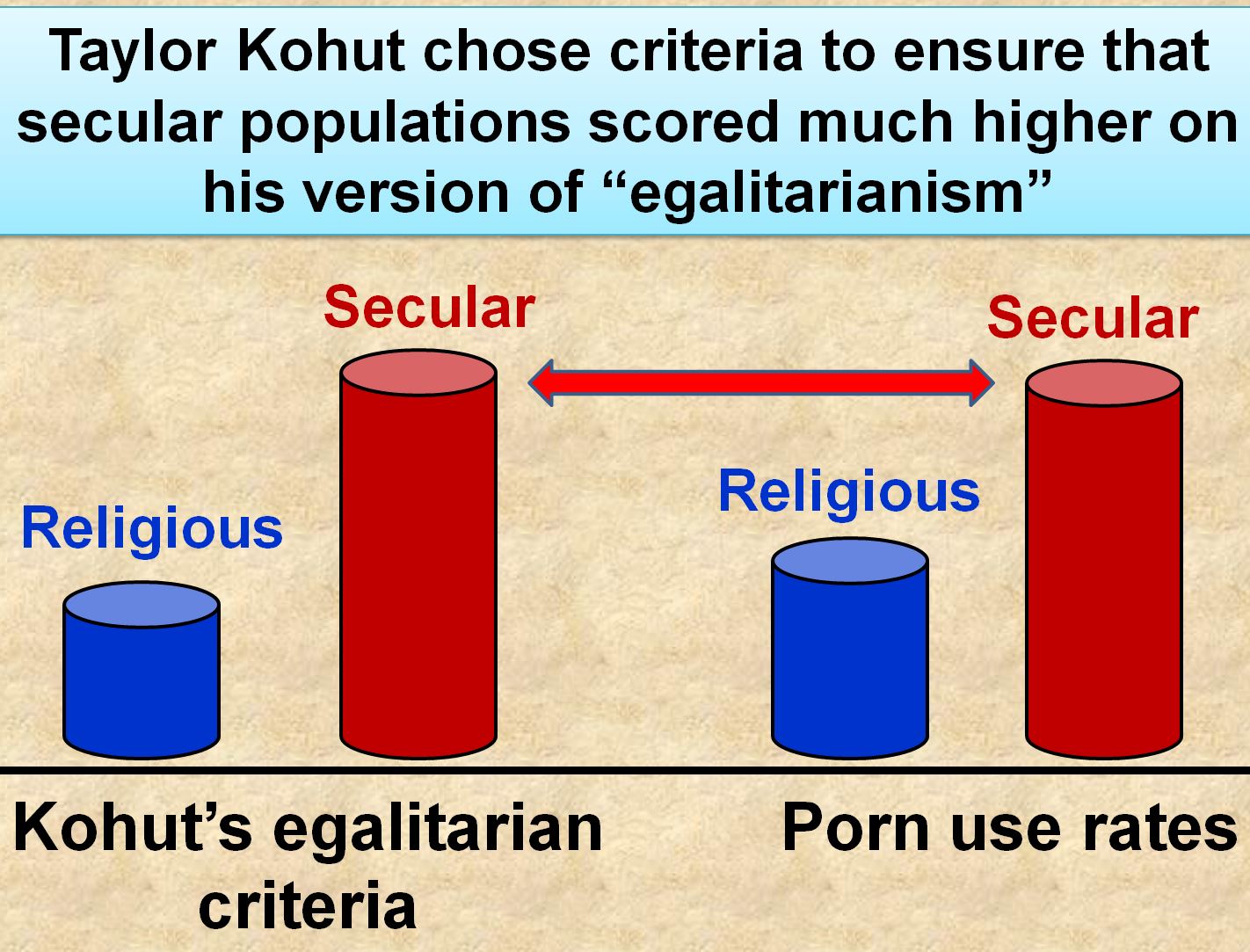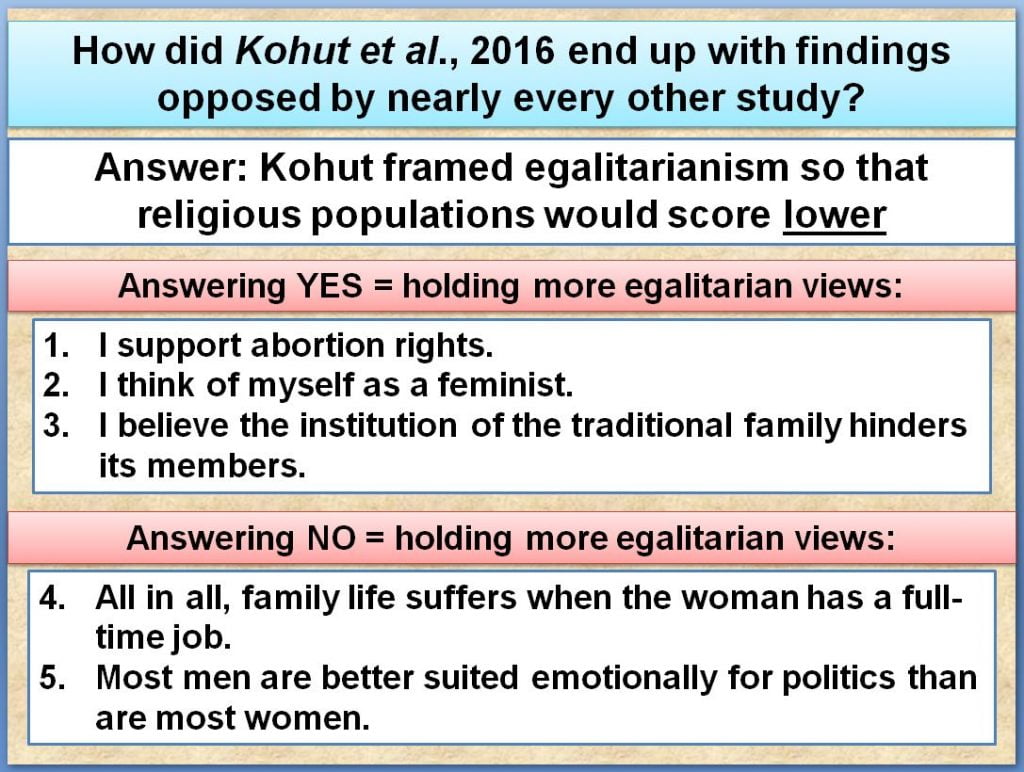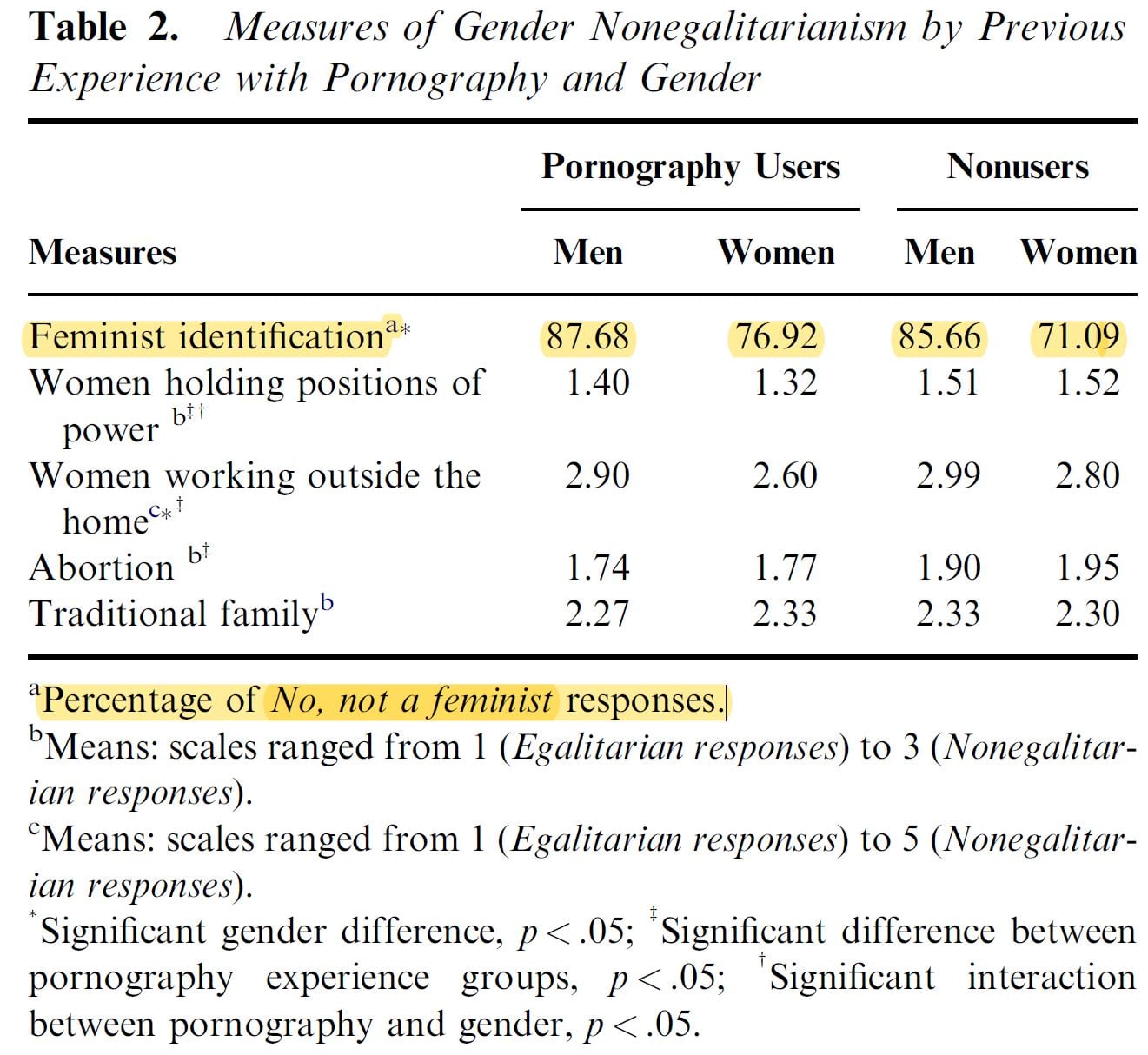The authors of this study framed egalitarianism as: (1) Support for abortion, (2) Feminist identification, (3) Women holding positions of power, (4) Belief that family life suffers when the woman has a full-time job, and oddly enough (5) Holding more negative attitudes toward the traditional family. No matter what you personally believe, its easy to see that religious populations would score far lower on Taylor Kohut’s 5-part “egalitarianism” assessment.
Here’s the key: secular populations, which tend to be more liberal, have far higher rates of porn use than religious populations. By choosing these 5 criteria and ignoring endless other variables, Taylor Kohut knew he would end up with porn use (greater in secular populations) correlating with his study’s carefully chosen selection of what constitutes “egalitarianism” (lower in religious populations). Then Kohut chose a title that spun it all.

But Kohut ignored a major finding in his own paper, which runs counter to his carefully contrived narrative. In Table 2, more male and more female porn users gave a “no, not a feminist” response — as compared with non-porn-users. In other words, a higher percentage of non-porn-users identified as being “a feminist!” Notice how Kohut’s table is purposely confusing. It reads as if a higher percentage of porn users identify as feminist. You need to check the footnotes to learn that his description is pure spin.
Moreover, Kohut’s findings are contradicted by nearly every other published study (see this list of over 40 studies linking porn use to sexist attitudes, objectification and less egalitarianism). An excerpt from this 2016 review of the literature: Media and Sexualization: State of Empirical Research, 1995–2015.:
“Sexually objectifying portrayals of women are a frequent occurrence in mainstream media, raising questions about the potential impact of exposure to this content on others’ impressions of women and on women’s views of themselves. The goal of this review was to synthesize empirical investigations testing effects of media sexualization. The focus was on research published in peer-reviewed, English-language journals between 1995 and 2015. A total of 109 publications that contained135 studies were reviewed. The findings provided consistent evidence that both laboratory exposure and regular, everyday exposure to this content are directly associated with a range of consequences, including higher levels of body dissatisfaction, greater self-objectification, greater support of sexist beliefs and of adversarial sexual beliefs, and greater tolerance of sexual violence toward women. Moreover, experimental exposure to this content leads both women and men to have a diminished view of women’s competence, morality, and humanity.”
Taylor Kohut has a history of publishing ‘creative’ studies designed to find little or no problems arising from the use of porn. In this 2017 study, Kohut appears to have skewed the sample to produce the results he was seeking. Whereas most studies show that a tiny minority of porn users’ female partners use porn, in this study 95% of the women used porn on their own (85% of the women had used porn since the beginning of the relationship)! Reality: Cross-sectional data from the largest US survey (General Social Survey) reported that only 2.6% of women had visited a “pornographic website” in the last month. Another article critiquing this study: New study says porn users have ‘egalitarian attitudes’ — so what? (2015) by Jonah Mix.
Kohut’s new website and his attempt at fundraising suggest that he just may have an agenda. Kohut’s bias is revealed in a recent brief written for the Standing Committee on Health Regarding Motion M-47 (Canada). In the brief Kohut and his coauthors are guilty of cherry-picking a few outlying studies while misrepresenting the current state of the research on porn’s effects. Their distorted and laughable description of the published neurological studies on porn users leaves no doubt as to their bias.
In 2019, Kohut joined a handful of pro-porn researchers and therapist formed a group to steal YBOP’s trademark while openly supporting the porn industry. See this page for details: Aggressive Trademark Infringement Waged by Porn Addiction Deniers (www.realyourbrainonporn.com). Kohut openly defended the RealYBOP twitter account, which posted over 1,000 tweets disparaging and defaming what it called, “anti-porn activists”. @BrainOnPorn was eventfully banned for targeted harassment and abuse.
Update (2018): In this 2018 presentation Gary Wilson exposes the truth behind 5 questionable and misleading studies, including this study (Kohut et al., 2016): Porn Research: Fact or Fiction?
J Sex Res. 2016;53(1):1-11. doi: 10.1080/00224499.2015.1023427.
Abstract
According to radical feminist theory, pornography serves to further the subordination of women by training its users, males and females alike, to view women as little more than sex objects over whom men should have complete control. Composite variables from the General Social Survey were used to test the hypothesis that pornography users would hold attitudes that were more supportive of gender nonegalitarianism than nonusers of pornography. Results did not support hypotheses derived from radical feminist theory. Pornography users held more egalitarian attitudes–toward women in positions of power, toward women working outside the home, and toward abortion–than nonusers of pornography. Further, pornography users and pornography nonusers did not differ significantly in their attitudes toward the traditional family and in their self-identification as feminist. The results of this study suggest that pornography use may not be associated with gender nonegalitarian attitudes in a manner that is consistent with radical feminist theory.
PMID: 26305435
DOI: 10.1080/00224499.2015.1023427


